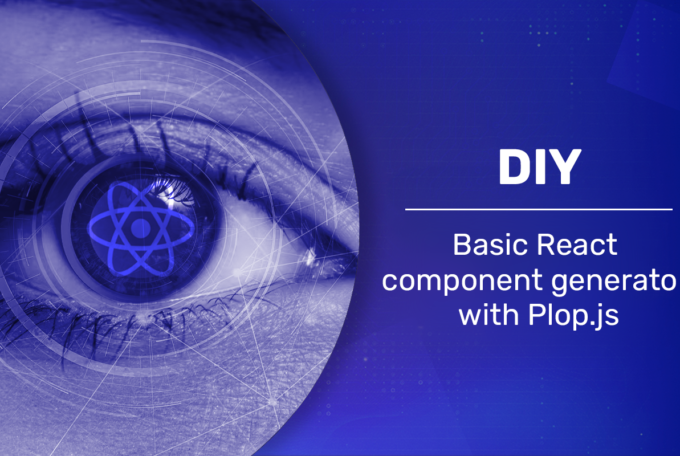Do you develop applications? Do you manage software? If stable development and increased technology security matter to you, check whether your software provider guarantees the best DevOps practices. This approach fluidly combines the work of all the people involved in the project. Software development and infrastructure management complement and overlap with each other in order to ensure best quality at all levels of the system. Thanks to this methodology, digital products can be created significantly faster, and it is much easier to develop these post implementation. See what the DevOps methodology is about and what benefits it offers. In IT projects at Stepwise, DevOps has ideal conditions for development, and has become an indispensable element of our brand DNA. Find out how beneficial it is for our customers.
DevOps – a job description or development methodology?
“Dev” + “Ops” (Developer + Operations)
Presently there are a lot of job offers for DevOps Engineers in the market. People working in this position are supposed to carry out the work of developers (development) and system administrators (operations). DevOps Engineers are the glue that binds the various individuals in IT projects. One of the major tasks included in this job description is ensuring a smooth exchange of information and communication between software development (Dev) and administration and infrastructure (Ops) departments.
The compartmentalisation of DevOps to just one position is a huge mistake, as DevOps has a considerably broader concept related to comprehensive software development methodology.
The major advantages of DevOps in IT projects:
– determining how we should manage an IT team in a project,
– indicating how we can ensure synergy between software development and infrastructure management,
– determining the quality indicators of a final digital product (quality assurance),
– shortening software development time and modifications to existing solutions,
– enabling integrating the best solutions from the various technologies,
– ensuring application and user security,
– minimising/shortening time-to-market.
DevOps combines qualified specialists, proven software development practices, flexible IT infrastructure, and advanced tools, in order to deliver values to the owners and end users of digital products.
Find out what characterises the DevOps methodology and its best practices.
Moving away from the waterfall approach
Any venture associated with new technologies is connected with some risk. Digital product development requires appropriate amounts of time, knowledge and money. Earlier IT project completion models treated these requirements ruthlessly.
For instance, the old-fashioned waterfall approach consists of particular “steps” in the project completion which should be undertaken one after the other. In this way, such iteration is complex and time-consuming. Its initial assumptions are difficult to change, and the changes require starting the entire project anew, which is why this method only works for projects with clearly delineated requirements and needs. In an industry of new technologies, where the environment is changing dynamically, such an approach is very unfavourable for the final shape of the software.
The DevOps model is a revolution in software development, as it deviates from the IT project completion cascade and focuses on delivering real values for users. DevOps works perfectly in agile application development methods, which assume an IT project is divided into short iterations. Any changes can be made quite frequently, without bearing huge costs. The development of digital products is then cheaper and faster than for old concepts.
Deployment frequency and monitoring
Deployment frequency indicates how often the software is updated. Deployments of new versions of the code can include error and bug fixing, improvement of functionalities, and additional application functions. Deployment frequency can serve as a measure for the effectiveness of using DevOps practices.
The continuous deployment approach (CD) is used in the DevOps concept. The DevOps software development method assumes dividing an IT project into smaller segments. Short iterations facilitate frequent easy-to-control changes, as well as testing and safe implementation in real time. In addition, this can be done automatically, not requiring the intervention of engineers. End users get access to applications with solid manufacturer support, and updates can also include cyber security and application extension with additional functionalities. As part of this concept, software implementation can be done for example once a month, once a week, and even multiple times a day.
What are the benefits of frequent deployment?
- You can monitor the entire process with ease.
- You can deliver your customers the functionalities they expect.
- You develop effective methods for handling crises.
- You reduce the number of errors in the software and the risk of system failure.
- The reliability of your digital product is enhanced.
This translates into end user satisfaction… and ultimately to your profits.
Development teams NO LONGER need to work 12h before deployment
If a digital product is intended to generate income, it should match end user tastes. Deployment of new functionalities or changing the application interface or code recently improved by a team of developers can enhance or worsen the User Experience. Due to the fact that DevOps assumes frequent code changes and continuous improvement in application operation, new deployments require particular attention from the entire team.
Controlled code deployment requires outstanding competences and particularly high code and infrastructure awareness from the project participants. As part of DevOps, prior to application implementation, the team of developers thoroughly test and evaluate the software operation and the system load. Identifying errors and potential issues on an ongoing basis fosters reducing the risk of damaging the company image. In order to improve this process, multiple advanced tools for testing, infrastructure and application management, and safe code deployment are used. A large number of those activities can be automated, which is why instead of devoting volumes of time to easy technical procedures, IT teams can participate in actual development in the project.
Moving away from depending on the environment
Application development in DevOps maximally facilitates future product modification and scaling. Rather than a monolithic physical virtual machine, the infrastructure is embedded in the cloud, partitioned into smaller microservices that cooperate with each other to create one ecosystem. In this way changes made in a particular part of the system do not impact the remaining segments of the environment. Tools such as Kubernetes enable efficient system management, easy starting and scaling of containerised applications, and shortening the time of the software maintenance. One essential advantage of DevOps is also the possibility of automating multiple activities previously performed by people.
One trend that influences application independency is containerisation. These days, software developers can close applications in a so-called image. Previously, for applications to run, it was necessary to configure each virtual machine or create a separate version of the application. Nowadays, advanced tools (Docker, Podman) have made it possible to run an application image in a container, making application development and operation independent of the limitations a particular system.
Evolution of agile
The DevOps methodology encompasses nearly every aspect of software development. In this way, IT teams can implement and develop effective CI/CD practices (continuous integration/continuous deployment). This has an impact on the continuous development of agile software development methods (Agile). This method assumes dividing a project into short iterations that are intended to deliver a specific element of the software. After creating a code fragment, the functionality is tested, evaluated, then developed or modified.
Iterative application development saves time, money and the stress accompanying code deployment. The division of the project into smaller parts also facilitates maintaining constant control over the product development. In this way, a business can flexibly match technologies to the changing needs of end users.

Time to market
In recent years, the new technology and cloud service market has been under extreme dynamic growth. An increasing number of companies are undergoing a digital transformation and launching new digital solutions. If you are developing software, you certainly know that creating a better product is no longer sufficient to achieve success. The time necessary to implement the software is of great significance.
DevOps was created to shorten the time needed for software development. The best practices of this approach include agile methods in software development. The human factor is frequently replaced with automation, machine learning and artificial intelligence. IT specialists can concentrate on creative work, business logic for the developed products, code creation, and UI and UX development.
Implementation of new versions of applications is also less time-consuming. In the past, the path to the implementation of a new version of an application was very complex and time-consuming. Developers created or corrected code and sent it to administration departments for testing. Prior to conducting tests, specialists responsible for the infrastructure had to create a new environment or configure an existing one. Following this chain of activities, a test was carried out and, on the basis of the outcomes, developers could implement the code or make necessary changes (in this case, the cycle started anew).
In the DevOps culture, prior to code deployment, developers can count on the support of advanced tools and automatic tests that in real time deliver information whether the software has any errors, so that the new version can replace the old one with no downtime.
Security assumptions – DevSecOps
When nearly every day there is a hacking attack or data leak somewhere in the world, it is extremally important for businesses to ensure the highest level of application and data security. There are companies where the departments in charge of technology security are still treated as just inspection bodies that impede developers in order to meet legal regulations and rules associated with appropriate code preparation.
DevSecOps is a combination of DevOps and Security. According to this approach, IT specialists responsible for security should actively participate in software development at every stage of the project. An active participation means suggesting specific solutions related to product cyber security, and not just have an informative and control function. This largely reduces the future risk of data leaks, system failure, or infringement of laws connected e.g. with personal data processing.
DevSecOps is a relatively new approach, and there is not yet a fixed scheme of conduct for specialists responsible for technology protection. There are indications that this pattern of action will never be created, as according to the DevOps methodology, specialists should perceive the project as a whole, and individually adjust optimum solutions for specific projects. The best DevSecOps practices have already been established, and they help in implementing this approach to the work of software developers. Conscious software houses have already been using these practices.
Check how Stepwise takes care of cyber security for their customers.
Dependency scans
Dependency scans can reveal dependencies and gaps in developed software, indicating those elements of the code that are particularly vulnerable to attacks and which require updating, correction or removal. The market offers advanced tools that analyse code and present a list of licenses of particular software segments dependencies.
Docker and security scans
Frequent code changes in DevOps require processes that ensure a high level of security in each deployment. There can be even several deployments a day. For this reason, it is worth getting to know security scans such as Trivy, Clair and Anchore that serve in evaluating the vulnerability of docker images, containers, databases and data repositories to attacks. Security tests allow for detecting potential gaps at multiple levels of software, prior to its implementation.
Health checks
Automated health checks enable evaluating the condition of both new and existing applications on an ongoing basis. As part of these tests, technical aspects such as processor usage, the number of used instances in the cloud, and bottlenecks during software implementation are checked.
An equal amount of attention is paid to team management and to educating project participants on DevOps. It is also worth monitoring the time required to solve typical application problems.
Autoscaling
The advanced DevOps culture is connected with the cloud. Cloud services offer a flexible choice of technologies, developers have a countless number of tools at their disposal, and users just pay for the resources they actually use. This accelerates software development and enhances its management. These are the major goals of the DevOps approach.
Click if you wish to find out more about cloud services.
Autoscaling is one of those cloud functionalities that is worth paying attention to in the context of the DevOps methodology. Appropriately configured cloud infrastructure makes application scaling independent of people. The system can check the demand for computing power of every segment of the software and, in real time, deliver the necessary resources for high application performance maintenance.
Monitoring
Effective and reliable monitoring is key to valuable feedback and making knowledge-based decisions. With DevOps this can be done without interfering with the completion of particular stages of software development.
Intelligent monitoring assumes the use of innovative tools that thoroughly check the code as well as the operation of the application itself and microservices in the cloud. The resulting reports enable correcting development errors on an ongoing basis and at a significantly lower cost than in the case of detecting them after the launch.
Combining the DevOps approach and the cloud native application methodology results in an extremely effective process of launching innovative digital products. A lot of cloud services not only identify gaps in security, system errors and decreased performance, but they are also able to fix them without human involvement.
Find out more about Cloud Native here.
Alerting
Effective monitoring and reporting is not sufficient. Although some technologies used in DevOps have the possibility of self-repair, some cases must require intervention or at least an IT specialist. For this reason, DevOps best practices include the preparation of an effective events notification system.
Any failure, error or negative event detected and fixed in an appropriate time does not have to cause damage to the application or brand. Alerts sent to relevant specialists are of key significance for quick and trouble-free code modifications.
Infrastructure as a code
Accelerated software development processes require effective building of a safe environment for specific applications. In order to shorten this process, specialists create, modify and describe particular versions of the environment. Advanced tools such as Terraform enable managing the infrastructure in an efficient and safe manner. Ready versions of the environment are turned on and configured extremely smoothly, which largely impacts the total time of project completion and change implementation.
Summing up, infrastructure as a code facilities running and recovering a functioning environment in the cloud much faster.
Continuous integration continuous delivery
The CI/CD approach plays a special role in the DevOps methodology. Its major purpose is to automate the process of frequent changes in the software. Continuous integration continuous delivery also encompasses methods of testing changes in the code, and requirements related to the security of implementations.
In very simple terms, “continuous integration” indicates how developers should make changes in the software and test new solutions, while “continuous delivery” focuses on automating the launch and implementation of new versions of applications into the production environment.
In order to make an effective use of CI/CD as part of cloud native, specialists can reach for such solutions as GitOps. This concept allows for managing manufacturing changes by means of just one Git repository, which also serves as a tool for code history management. Any actions in the cloud are registered, which is why it is easy to roll back to a specific software version. The change implementation process can be described and automated with a configuration file, mostly YAML. In this way, the configuration of processes in CI/CD can be independently reproduced by the system, which eliminates human error in future implementations.
Having made changes in the repository, tools like GitLab (or Argo CD for Kubernetes) independently update the infrastructure so that it meets the requirements previously defined by the developer. Prior to implementation the code is tested, and is implemented only after the system does not detect any errors. A lot of errors in the code are detected at early stages of the change implementation process, which translates into high application reliability and a reduced risk of losses associated with failure to detect these errors at the right time. After implementation, the new version of an application can run alongside the old one. The system gradually transfers traffic from the old application to the new one, maintaining a high level of product availability.
Thanks to CI/CD, developers can concentrate on delivering added value to applications. Due to the fact that implementations are made automatically, specialists are more involved in creative software creation and development. Every stage of the project is performed with specific business needs in mind, where particular functionalities in the code are added in response to the current expectations of potential customers. This is beneficial for both the end users and businesses.
DevOps at Stepwise
DevOps is an indispensable part of the software development culture at Stepwise. We believe that one DevOps Engineer is not sufficient to effectively implement this methodology. We have always wished to increase customer satisfaction, and therefore we included DevOps in the DNA of every level of our brand. What does it look like in practice?
Every IT specialist at Stepwise needs to represent the top level of theoretical and practical experience in digital product development, and to be equipped with communication skills, fluent knowledge of English, and well-developed business awareness. In this way, our partners can contact any project participant and discuss technical aspects of a selected functionality and business justification of the implemented solution.
We use a similar principle for implementing the DevOps methodology. Every specialist treats the product as a whole, which means delivering premium quality so that other team members can perform their tasks freely. Not only are our developers experts in coding, but also in the development and configuration of multifunctional technological infrastructure (we specialise in cloud services).
In our projects we have been using cloud services (AWS, GCP and Azure). Our developers are excellent at advanced solutions for containerisation and management of dispersed applications (Kubernetes, Docker). We use tools in the cloud widely, not just at the level of software development and management, and we are able to implement an effective system of communication, which significantly accelerates the development of your application. Reliable software for videoconferencing and solutions for asynchronous communication are essential for effective development of your project.
We know how important time-to-market is for our customers. Our team has developed their own extremely effective agile methodology that enables express checking of the potential of a created digital product (we use MVP and PoC for this). Time matters considerably in business, which is why we can prepare several versions of the same application for you, suited to various devices and systems.
Selected DevOps operations in Stepwise projects
What else do we do at Stepwise in order to deliver our customers the best part of the DevOps culture in IT projects?
– all our projects are either automatically deployed on code changes, or in some cases it is one-click deployment to production,
– all our projects can be run with a single command,
– after every change all apps are deployed to cloud,
– our deployment infrastructure is based mainly on Kubernetes,
– we are using autoscaling in the cloud which saves time and money,
– up to date deployments in the dev environment – the client can always see the current state of development
This approach lets you focus on software development rather than on infrastructure. Regular monitoring and the use of the Feature Flag technique and A/B tests allow us to deliver the best quality in the code and particular functionalities of the application at every stage of software development. Contact us and find out more.




